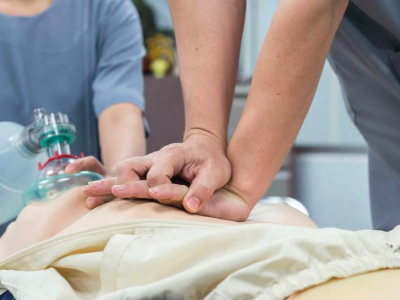Abstract
Dental professionals are in front line of taking care of medically compromised patients. One condition that can arise in daily care is chest pain and angina for a highly anxious patient. This review article summaries the pathophysiology, diagnosis, risk factors and complications associated with stable and unstable angina, and myocardial infarct. It is meant to be a summary review to refresh information on this common condition for the dental professionals dealing with these emergencies in dental office. Keywords Chest Pain, Myocardial infarction, Anxiety, Treatment

Chest pain can be a medical emergency in the dental clinic – so you must know all about it!
Chest pain and heart disease is a condition affecting significant part of the population. As dental professionals, we are constantly dealing with anxious patients or patients with cardiac conditions that could present themselves as an emergency in dental office. Understanding Ischemic heart and myocardial infarct and how to manage the patient in dental chair is critical.
Ischemic heart disease is notorious for its classic presentation with a crushing retrosternal chest pain in patients with risk factors suggestive of atherosclerosis: HTN, smoking, being a male 55+ years old (or a female 65+ years old), and–of course–hyperlipidemia 1,2,3. There is a continuum of stages from perfectly healthy coronary arterial circulation to ischemic transmural myocardial necrosis (characteristic of ST segment-elevation myocardial infarction, or STEMI) 1,3. When evaluating a patient with a common symptom like abdominal pain or headache, it is crucial to consider the most life-threatening conditions with a common enough epidemiology before worrying about more benign ones, and the evaluation of chest pain is no different. Thus, anyone who presents with chest pain–even in an outpatient setting where the probability of myocardial infarction (MI) is lower relative to the inpatient setting–the patient must at the very least be screened for life-threatening causes of chest pain.
In the case of MI, especially, its presentation can commonly deviate from the classic presentation of a crushing retrosternal chest pain or pressure radiating down the left arm 3. 20% of patients with myocardial infarction present with little to no pain at all, many of whom are diabetics 3. For this reason, there is generally a relatively low threshold for screening of acute coronary syndrome (ACS), which includes unstable angina, non-ST elevation MI (NSTEMI), and STEMI in order of increasing severity of myocardial ischemia respectively.
Stable Angina
Stable angina is a mild form of myocardial ischemia that is characterized by its predictability: Increased demands of the heart due to exercise or emotional stress crossing a certain threshold out of demand to myocardial oxygen supply causing a retrosternal chest discomfort lasting for several minute. This is commonly the condition seen in dental patients especially after local anesthesia injection. While stable angina, in itself, is not all that threatening, it can progress to acute coronary syndrome. Recognition and immediate treatment could alleviate this with minimal steps. Those including oxygen, sublingual nitroglycerine aspirin.
Unstable Angina
Unstable angina is a chest pain that is worse than stable angina brought on with relatively little or no physiologic stress without any irreversible myocardial damage yet. Unstable angina can present clinically as:
- increasing episodes of chest pain at a lower threshold in a patient already with stable angina,
- angina pectoris chest pain at rest or with no exertion, and
- sudden onset of serious angina pectoris without prior progression.
Non-ST elevation MI (NSTEMI)
NSTEMI presents almost identically to unstable angina, but the features may be slightly more severe. Unstable angina and NSTEMI appear identical on electrocardiogram with either T-wave inversions or ST-segment depressions. The only real way to tell the difference is with markers of cardiac necrosis, like cardiac troponins (cTn’s, especially cTnI and cTnC) and creatine kinase MB, where unstable angina has no definitive evidence of necrosis while NSTEMI does. However, untreated unstable angina can progress to NSTEMI or even STEMI as a function of the underlying pathophysiology.
ST elevation MI (STEMI)
It is the most severe type of myocardial ischemia. The classical presentation of a STEMI is
- transmural ischemia and
- necrosis.
This would be visible once 12 lead EKG is obtained. ST segment elevations are acutely to “pathologic” Q waves as remnants. If the artery is only partially occluded, either unstable angina or NSTEMI will manifest as a function of the degree of occlusion. If the thrombus resolves on its own and no findings are observed on EKG, the atherosclerotic plaque may still thicken and eventually lead to an ACS episode.
Pathophysiology – how one thing leads to the other
The pathophysiology of these cardiac conditions starts with atherosclerotic plaques within the coronary circulation occluding the arterial lumen over time, but the artery compensates by becoming larger to maintain a lumen large enough for sufficient blood flow. This process however can only proceed to a certain limit; and eventually, the lumen will get too narrow for myocardial oxygen supply to always meet myocardial oxygen demand. Clinically, this presents as stable angina.
If there is damage to endothelial cells at the atherosclerotic plaque, thrombogenic material within the plaque is exposed to the blood moving through this portion of the coronary circulation. Platelets can become activated and aggregate forming a plug; and activation of the coagulation cascade prompts formation of a fibrin clot. This thrombus on the damaged atherosclerotic plaque can enlarge and proceed towards occluding the afflicted coronary arterial lumen. If an epicardial artery (as is often the case) is involved, complete occlusion quickly leads to transmural ischemia and necrosis–creating the presentation of a STEMI.
If ischemia persists for too long: the heart cells will be left in a state of “shock,” conferring a loss of contractile function of such cells for weeks. Irreversible damaged cardiac muscle undergoes a series of pathologic changes that leave the patient susceptible to potential complications of myocardial infarction. Myocytes that lose access to oxygen for too long lose the ability to form enough ATP to drive cellular processes, causing formation of lactic acid within and loss of appropriate electrolyte handling of the afflicted heart cells. Subsequently, cells become acidic and edematous and fail to maintain an appropriate transmembrane electrical potential difference. Cell death ensues following leakage of ions through gap junctions and accumulate intracellular calcium. The constant leakage of cations from damaged cells through gap junctions can inappropriately depolarize adjacent cells, possibly precipitating an arrythmia almost immediately after an MI.
Eventually the cell membranes of the dying cardiomyocytes leak proteinaceous contents, causing local interstitial edema and elevation of cardiac necrosis biomarkers in the serum. Acute inflammation occurs with arrival of PMNs and macrophages; phagocytosis of the necrotic debris makes the afflicted muscular wall thinner. The afflicted region of myocardium becomes much more friable than normal in this period and increasing the risk of ventricular wall rupture, papillary muscle necrosis, ventricular wall aneurysm. Over time the tissue undergoes fibrosis leading to impaired ventricular mechanical function and formation of re-entry circuits that can precipitate tachyarrhythmias.
Inappropriate re-entry circuits can form causing a tachyarrhythmia, and damage of conductive pathways leading to bradyarrhythmia, bundle branch block, or an AV nodal block. Throughout this process, motion of afflicted myocardial tissue may be akinetic, hypokinetic or dyskinetic. These movements can confer either:
- diastolic dysfunction if the afflicted region is stiff and doesn’t expand or relax or
- systolic dysfunction due to a loss of or inappropriate contraction.
These inappropriate movements of the myocardial wall may be detectable on echocardiography.
Complications – what happens after MI.
Some complications of myocardial infarction carry a very poor prognosis, even after management medically or invasively:
- Ventricular wall rupture creates a pericardial tamponade in an already sick patient.
- Ventricular septum rupture causes left-to-right shunting and thus hypoperfusion. This is detectable as disproportionately elevated O2 content in the right ventricle in comparison to the right atrium.
- Papillary muscle rupture can induce a life-threatening valvular regurgitation or at least one serious enough to induce left-sided heart failure.
- Involvement of the posterior descending artery in many patients with MI can produce right-sided heart failure features out of proportion to left-heart failure.
- Ventricular tachyarrhythmias like ventricular fibrillation can cause sudden cardiac death before arrival to a medical team. Thanks to implementation of Automated External Defibrillators (AEDs) in many public settings, the incidence of sudden death from ventricular tachycardias are falling.
To conclude
As dental professionals it is important to have some understanding on how to manage these patients immediately. Having emergency kits and AEDs in dental office and being able to provide care immediately while waiting for EMS to arrive could be significant difference between major morbidity and mortality versus saving the patients.
References
(1) Berg DD, Sabantine MS, Lilly LS. Acute Coronary Syndrome. In: Lilly LS. Pathophysiology of Heart Disease: An Introduction to Cardiovascular Medicine. 7th ed. Wolters Kluwer; 2021: 172-201.
(2) Mitchell SK, Lipsky MK. Chest Pain. In: Mitchell SK, Lipsky MK. Blueprints Family Medicine. 4th ed. Wolters Kluwer; 2019; 45-49.
(3) Morrow DA. Chest Discomfort. In: Loscalzo J, Fauci A, Kasper D, Hauser S, Longo D, Jameson J. eds. Harrison’s Principles of Internal Medicine. 21st ed. McGraw Hill; 2022. Accessed May 17, 2022. https://accessmedicine.mhmedical.com/content.aspx?bookid=3095§ionid=262789253
Acknowledgement
There is no conflict of interest or funding associated with this paper.
Author Name Dr Arjavon Tin Talebzadeh & Dr Nojan Talebzadeh
Author Bio
Arjavon Tin Talebzadeh currently is a third year medical student at California Northstate School of Medicine, Elk Grove, California.

Nojan Talebzadeh, M.D., D.M.D., J.D., F.A.C.S. is an attending Oral and maxillofacial Surgeon at South County Surgery Center, Chula Vista, California.


















Comments